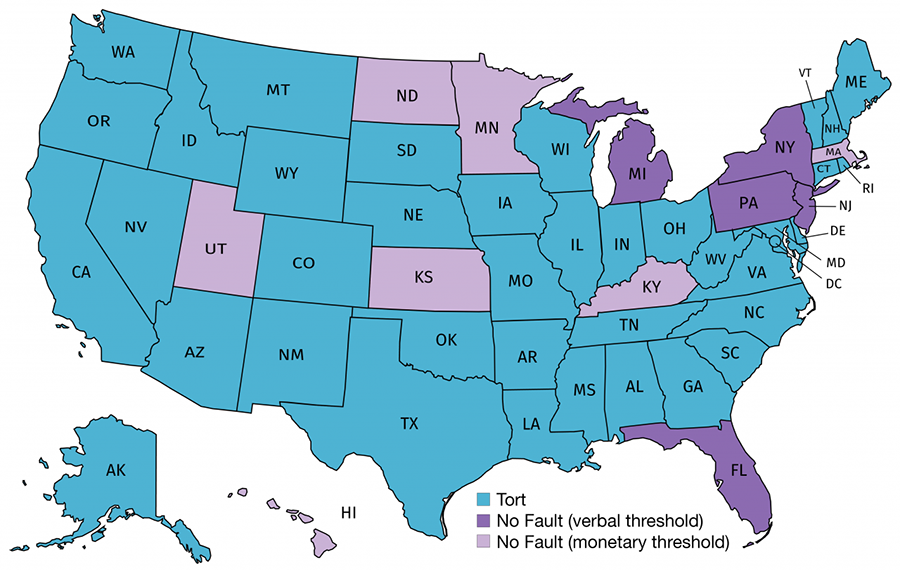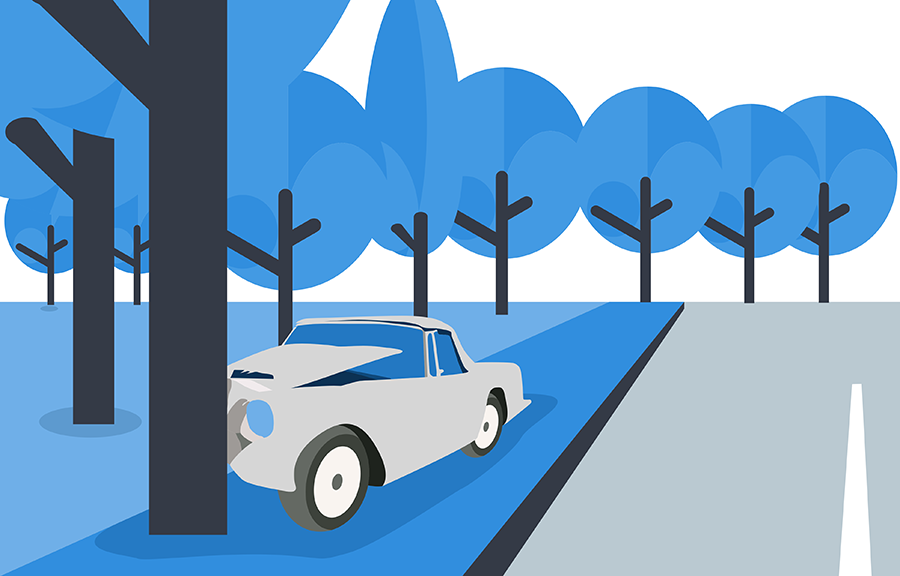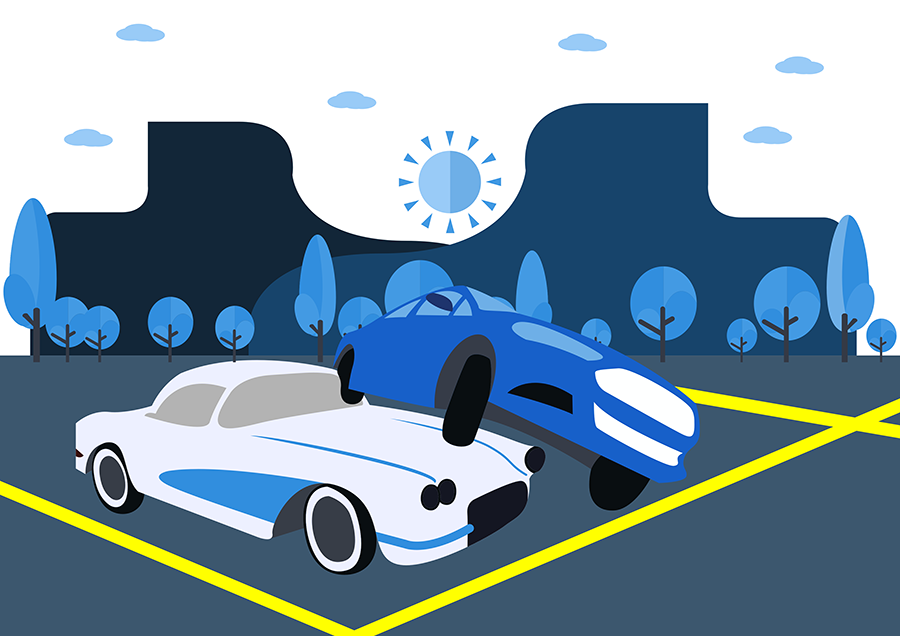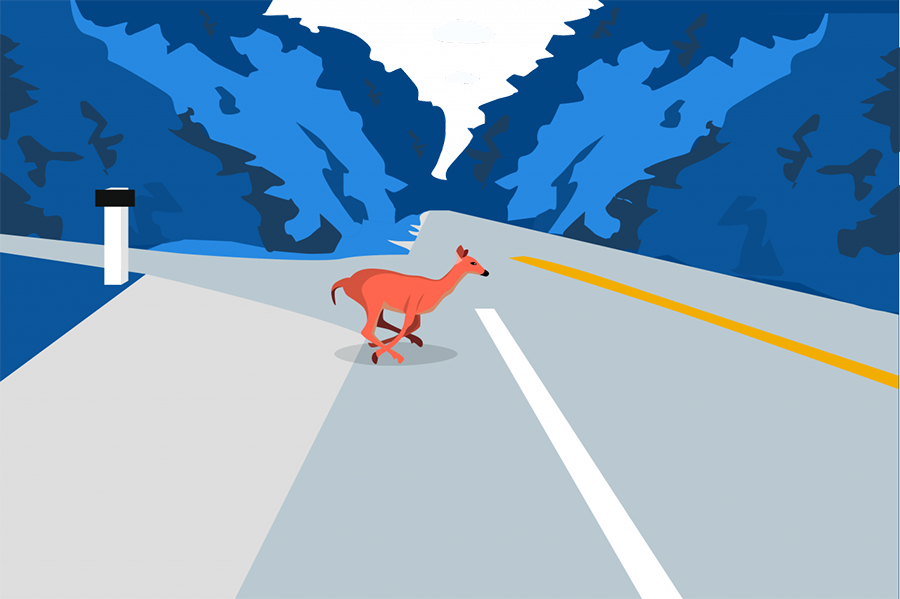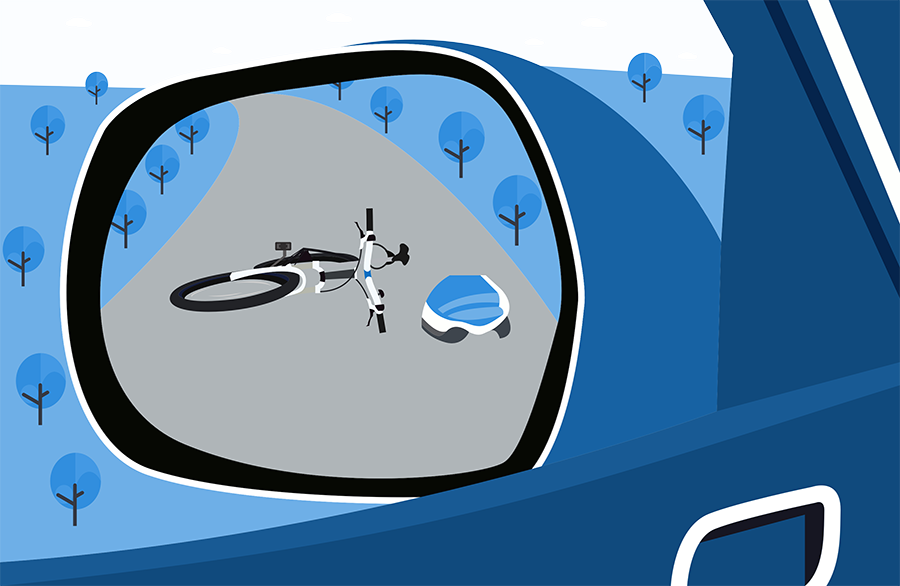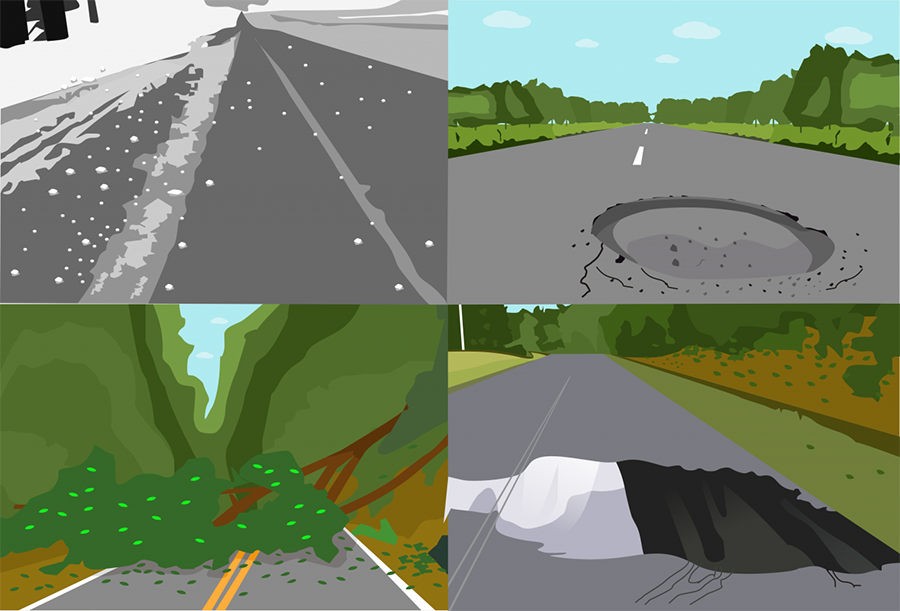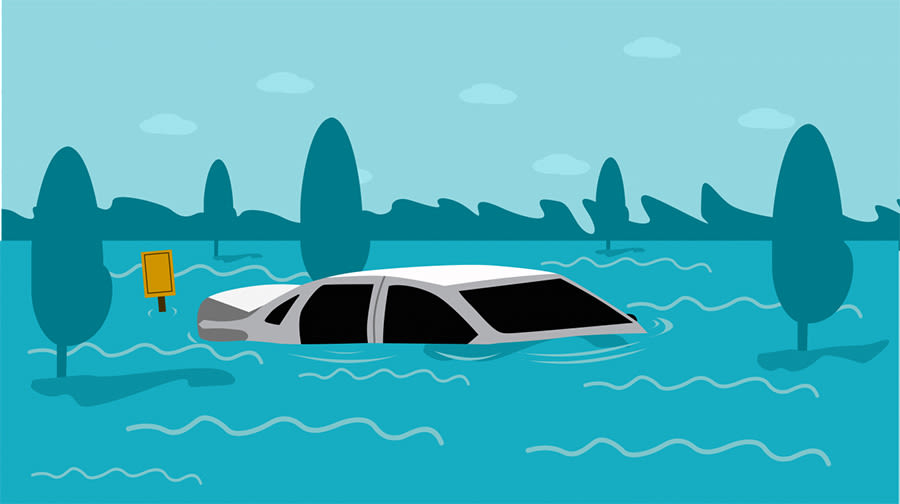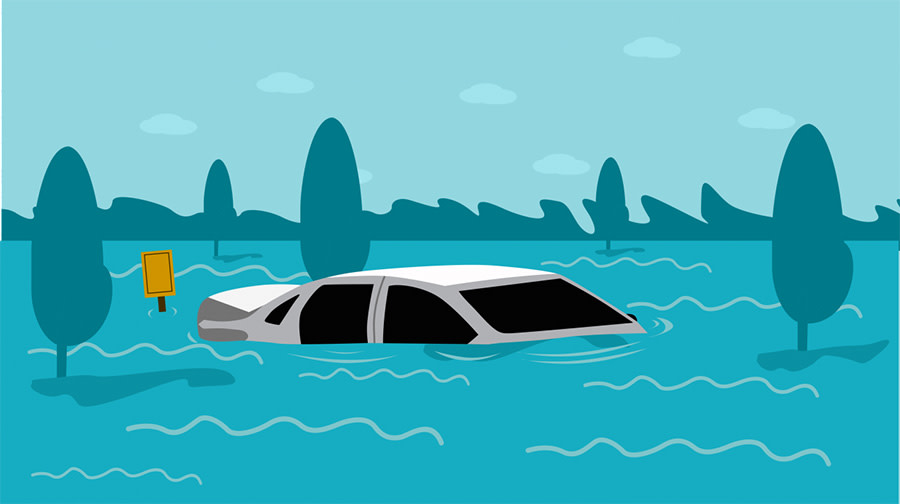
When Car Accidents Occur How Does Collision Coverage Apply?
TABLE OF CONTENTS
As discussed elsewhere, insurance can be complicated. One example is the differences in how insurance deals with collisions your vehicle may suffer. Collision coverage often applies, but not always. To break it down, we take a look at the top possibilities for damage to a vehicle.
For each case, we've detailed who is likely to pay and what coverages could be used for the collision. There's also a small tangent about how prices may be affected in some situations. Before jumping to a particular case, we advise reading up on the topic of fault below--or at least determining whether you live in a no-fault or tort state (Map).
First: a quick primer on fault
No-fault state
In a no-fault state, the insured almost always gets coverage from their own insurance policy, regardless of the incident. The exception to this is some no-fault states have provisions that allow drivers to sue for additional compensation if the injury or damages exceed some established threshold. States typically define this limit either verbally (severe injury or death) or monetarily (damages exceeding a certain dollar amount).
Thus, if one driver crashes into another, each driver has self-coverage regardless of fault.
Monetary threshold: Hawaii, Kansas, Kentucky, Massachusetts, Minnesota, North Dakota, and Utah.
Verbal threshold: Florida, Michigan, New Jersey, New York, and Pennsylvania.
In New Jersey, Pennsylvania, and Kentucky, drivers can reject the threshold altogether and sue for injuries regardless.
At fault (tort) state
Fault in an accident is typically defined as a percentage. In a case where no one is at fault, two drivers would share 50/50% blame. If one driver is more at fault it could be 25/75%, and so on. The coverages used for compensation are dependent on state rules revolving around these percentages of fault, which can be broken into three types: pure comparative fault, modified comparative fault, and contributory fault.
Comparative negligence / pure comparative fault
With this type, each driver can receive compensation for damages from the other driver (or their insurer) based on their proportion of fault. Thus, in a case where you have 10% of the fault and they have 90%, you can recover 90% of damages, while they can recover 10%.
States Present
Alaska, Arizona, California, Florida, Kentucky, Louisiana, Mississippi, Missouri, New Mexico, New York, Rhode Island, South Dakota, and Washington
Modified comparative negligence
Here, two sub-types exist: the “50% Bar Rule” or the slightly more generous “51% Bar Rule.” With both types, a driver cannot recover any damages if they are considered 50% or 51% responsible. If below that threshold, one driver can collect from the other driver (or their insurance). However, the recovery amount is limited to their degree of fault. (e.g. 45% at fault, only 65% of damages are recovered).
States Present
50% Bar Rule
Arkansas, Colorado, Georgia, Idaho, Kansas, Maine, Nebraska, North Dakota, South Carolina, Tennessee, Utah, and West Virginia.
51% Bar Rule
Connecticut, Delaware, Hawaii, Illinois, Indiana, Iowa, Massachusetts, Michigan, Minnesota, Montana, Nevada, New Hampshire, New Jersey, Ohio, Oklahoma, Oregon, Pennsylvania, Texas, Vermont, Wisconsin, and Wyoming.
Contributory negligence / pure contributory negligence
This is the most severe case. If a driver is found even 1% at fault, they can collect nothing from the other driver (or their insurance). Here, there is no proportionate compensation since a driver can only collect 100% of their damages, but only if they are 0% at fault for the accident.
States Present
Alabama, Washington D.C, Maryland, North Carolina, and Virginia.
Collision coverage with another vehicle while driving? Yes.
When collisions occur with another vehicle, the insurance coverages involved depend on two major factors. Namely, whether the driver lives in a no-fault state and, if they don’t, then who is at fault. For information about dealing with the accident itself and further details about how insurance is involved, see what to do after an accident.
No-fault state
Vehicle Damage
For damage to the cars, each driver uses their own collision coverage.
Personal Injury
For personal injuries, personal injury protection (PIP) provides compensation. PIP tends to cover medical bills and lost wages, but may also provide reimbursement for transportation to medical appointments and even lawn repair (if necessary), depending on the state and insurer.
Another coverage that may be used for personal injuries is Medpay, which is a more limited version of PIP that tends to only cover medical bills. Keep in mind that both PIP and Medpay are subject to limits selected by the driver when they purchase their policy. If costs exceed these, then the driver is on the hook for the rest unless they are able and willing to sue the other driver for the rest.
At fault (tort) state
Vehicle Damage
Based on the fault rules mentioned above, let’s assume you can collect at least some of the damages from the other driver’s insurance. Whatever the amount recovered, it will be via the other driver’s property damage (PD) coverage up to its associated limit.
If they do not have enough coverage, then your own insurance policy can step in to fill the gap with underinsured motorist property damage (UIMPD). Thus if you have $50,000 in damages and the other driver only has $25,000 of PD coverage, you could collect the other $25,000 from your UIMPD coverage. However, in some states insurers will not allow you to use your UIMPD coverage if its limits are lower than the limits of the other driver's PD coverage. Fortunately, this is a relatively inexpensive coverage to have.
If a driver can’t use their UIPMD coverage or doesn’t have any, collision coverage can apply instead. The downside to that is the deductible that must be paid before the insurer covers the rest.
Personal Injury
In this situation, assuming you're collecting from the other driver, it will be their bodily injury (BI) coverage, up to its associated limit.
As with vehicle damage, your own insurance can step in if the other driver does not have enough coverage. Underinsured motorist bodily injury (UIMBI) will be the primary coverage to do so. If UMBI is not enough, then you can also use personal injury protection (PIP) or Medpay.
I hit a tree (or another object), will collision coverage protect me? Yes.
Vehicle or Property Damage
We’ll go with trees for this example. However, the same rules apply to other stationary objects such as light poles, road guardrails, etc. If the driver is the one who drove into the object, insurance covers the damage under their collision coverage. However, if the object collided with them, such as a tree branch falling on the car either while parked or driving, then comprehensive coverage would be applicable instead.
One special case is where the object is something that belongs to someone else; for instance, a tree, mailbox, pergola, house, etc. Here, damages to the vehicle are still covered under collision coverage. Damages to the object, however, fall under the driver’s property damage coverage. In the case of a tree, this would include the cost of removal as well as a replacement.
Personal Injury
Insurers cover injuries either with Medpay or personal injury protection (PIP) coverage. One can also use their health insurance instead if they prefer.
Does collision coverage apply when a car is hit while parked? Generally, yes.
Hit and Run Insurance Claim
Vehicle or Property Damage
Let's say the driver's vehicle is damaged and the perpetrator gets away unseen. One can generally use uninsured motorist (UM) coverage to pay for damages. There are two types of UM coverage: property damage (UMPD) and bodily injury (UMBI). The former of the two, UMPD, applies specifically to damages to your vehicle (or other property).
However, only some states require UM, while others offer UMBI but not UMPD. Other states, however, do not allow UMPD to pay for hit-and-run damages. These include California, Colorado, Georgia, Illinois, Louisiana, and Ohio which we know of. In those states, or in cases where you don’t have UMPD coverage, you can use collision coverage instead. The reason UMPD is preferable is that doesn’t require a deductible. It is subject to monetary limits (selected by the driver at policy inception) however. Questioning an agent about whether these coverages are present (and to what degree) is certainly worth the time it takes to ask.
Personal Injury
If you suffer an injury in the incident, a few coverage possibilities apply to uninsured motorist bodily injury (UMBI), personal injury protection (PIP), or Medpay. UMBI is generally the first to kick in, but if the driver doesn’t have it, one can generally use one of the other two. None of these three options have deductibles involved, the coverage used does not matter much, with one minor caveat.
Namely, some insurers differentiate between “primary” and “secondary” Medpay coverage. If primary, then Medpay will cover medical bills up to its limits. After that, the driver has to tap into their health insurance. With secondary, health insurance applies first, and Medpay kicks in after (though it will pay any health insurance deductibles the driver has to pay).
Steps you can take in an at-fault (tort) state to find the other driver:
There may be surveillance footage or witnesses that can help you learn more about who caused the damages.
Filing a police report is also advisable. Some police departments even have online reporting available, which makes doing so fast and easy. There is often a certain dollar limit of damage that is permissible for filing online reports. Beyond that limit, one must file directly with an officer.
Let's say the damages are significant enough, surveillance footage is available, or there are witnesses with useful information. Here, it may be wise to have a police officer come to the scene. They can document the incident, collect evidence, and gather witness testimony. This allows them to create a more detailed and useful police report that could lead to finding the other driver.
Non-Hit and Run Claim
Sometimes you are present for the incident, or the other driver may leave a note with their contact/insurance info. Here’s what to expect in this situation.
No-fault state
Having the other person’s information won’t matter much since you’ll still be using your own collision coverage in this situation.
At fault (tort) state
Here, you can follow up with the other driver’s insurance. Their property damage coverage will pay for the costs of repairs (and likely the rental car if one is necessary). In some cases, the other driver will not have adequate protection to cover the costs of repairs. When this happens, underinsured motorist (UIM) coverage can pay for the rest.
This is often optional coverage. Sometimes insurers bundle it with UM coverage, and sometimes they treat it as separate. This largely depends on the state. If you don’t have this coverage, you may have to sue the individual for the remaining damages in small claims court.
If someone hit my parked car will my insurance go up?
Perhaps surprisingly, according to a study by the Consumer Federation of America, it’s quite possible that insurance rates will increase even if a driver is not at fault. At least two states, California and Oklahoma (and perhaps others) are exceptions to this. But in other states the practice is common.
The amount of increase varies by state and insurer. A trend exists, however, where people of higher socioeconomic status get preferential treatment. Drivers with higher incomes paid $78 or 6.6% more on average. Moderate-income drivers paid $208 or 9.6% more. Of the 5 insurers sampled State Farm was the only insurer that never appeared to have a penalty, while Progressive had the highest surcharges.
Collision coverage with a deer or other animal? Typically not.
Unfortunately, this type of crash is all too common. According to the National Safety Council, there were over 500,000 crashes with deer alone in 2003. State Farm reports that the average cost of repairs from incidents like these is just under $4000. They also have a state-by-state map with the odds of such a crash in 2015-2016 with West Virginia topping the list at a 1 in 41 odds.
Vehicle Damage
Generally, collisions with deer and other wildlife receive protection via comprehensive coverage, instead of collision coverage as one might expect. Collision coverage is only used is if the driver hits the animal but they had time to avoid a crash. For example, a deer standing in the road, versus suddenly jumping into the road in front of the car.
The reason for this distinction is that comprehensive coverage protects against random, unpredictable damages. A deer suddenly jumping out into the road (or things like theft, vandalism, or fire). Collision coverage, on the other hand, protects specifically against crashes with other cars or objects.
Personal Injury
If injured, a driver can use Medpay or personal injury protection (PIP) coverage to pay for medical bills. As mentioned in more detail above, PIP is a more robust coverage than Medpay. It tends to cover a wider range of costs associated with an injury.
Collision coverage with a cyclist or pedestrian? Sometimes.
As a Driver
No-fault state
As in other cases, the driver's collision coverage will apply for vehicle damages. For personal injuries, they would use PIP, Medpay, or health insurance.
At-fault (tort) state
If the cyclist is at fault, and your vehicle is damaged or you are injured, their auto coverage (if they have any) won't be of much use. However, you may be able to recover damages via their renter's or homeowner's insurance, if they have any. These insurance policies will often provide coverage for damage caused by the insured while engaged in covered occurrences (such as sporting activities like bike riding). If they don't have such coverage, and you can't work out an arrangement, then suing in small claims court may be the only choice.
If you're at fault for the incident, collision coverage will deal with any damage to the vehicle. PIP, Medpay, or health insurance will cover personal injuries. The cyclist will likely make a claim against your auto policy for their damages as well.
As a Cyclist / Pedestrian
No-fault state
In some no-fault states, if you're a cyclist or pedestrian who gets hit by a car, your auto insurance will cover your injuries. There may be conditions though. In New York, for example, three criteria are necessary:
The incident must occur within the state.
The vehicle must have registration in the state.
The bike or pedestrian must have come into physical contact with the vehicle. Swerving and falling won't count.
At-fault (tort) state
If the driver is at fault, you can receive compensation for personal injuries via their bodily injury coverage. Damage to the bike should similarly have coverage via their property damage coverage.
If you're at fault, the driver cannot make a claim against your auto insurance to recover any damages. However, if you have homeowner's or renter's insurance, you may find protection there.
Collision coverage without insurance? Clearly not.
It's hard to apply for coverage when there is no insurance policy to back it up. This scenario is covered in more detail in our article on driving without insurance.
Collision coverage with a road hazard? Most of the time.
A road hazard is anything on or on the surface of the road that can cause a driver to have an accident. Things like sharp objects, oil slicks, ice, potholes, or construction debris all qualify. In most cases, damages from encounters with these will have protection via collision coverage. The only exception where comprehensive coverage would be used instead is if the road hazard actively collides with you instead of you simply hitting it. Examples include rocks or mud rolling down a slope, a tree branch falling, a sinkhole opening up, or a truck spitting up gravel.
Collision coverage with mother nature? No.
When the weather has it out for a car, there is no contest on who comes out on top. In these cases, comprehensive coverage applies to cover losses for the driver. Fortunately, comprehensive coverage is generally far cheaper than collision coverage. One benefit of this is that it makes carrying lower deductibles more affordable, i.e. you pay out less when incidents like these occur.
Collision coverage with vandals or thieves? Nope.
Comprehensive coverage has your back here. Simple as that. Regardless of state or situation or fault. As mentioned before, having lower deductibles on comprehensive coverage is much more affordable than on collision. Something to consider.
TABLE OF CONTENTS


Trying to find the best insurance?
We'll help you find the policy that offers the best value for your situation.
Further Reading

Navigating the Digital Insurance Landscape Considerations
A look at the immense value and high customer lifetime potential within the insurance sector.
Read article
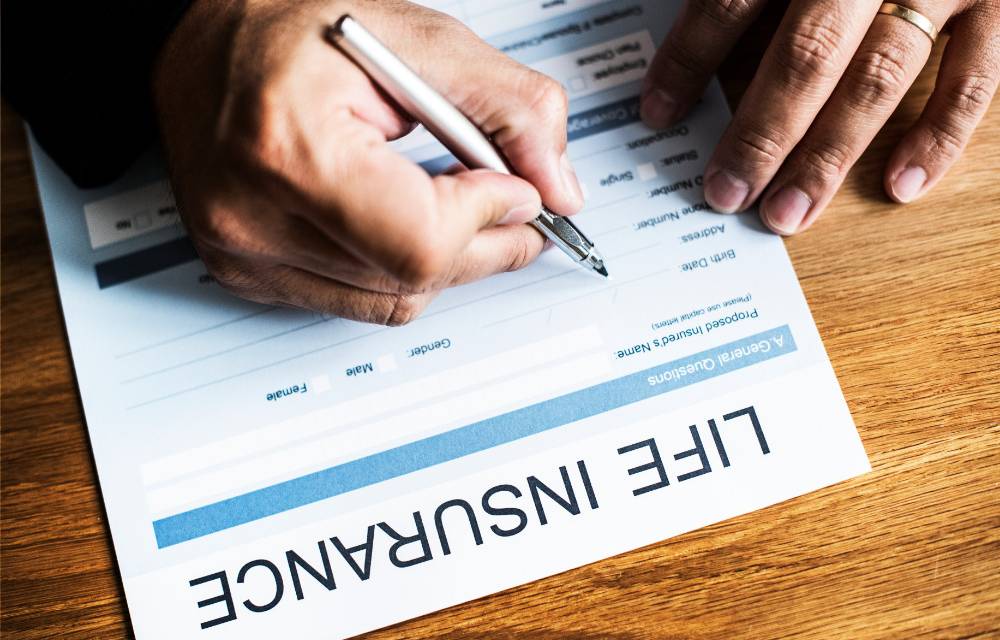
When is Term Life Insurance Worth it?
Decide if term life's advantages are worth it: compare whole vs term life insurance, assess top term providers, and delve into in-depth reviews.
Read article

Insurance Binder: Bridging Between Coverage and Confirmation
From car loans to rental properties, insurance binders are required in a variety of situations. Discover the ins and outs of these essential documents.
Read article

Haven Life Review: Providing Prudent and Protective Policies
Uncover the benefits and drawbacks of Haven Life's term insurance policies, along with eligibility details, pricing, and customer feedback..
Read article
Start Comparing Quotes
Search from our learning center to learn everything from how to easily switch your car insurance to the ins and outs of home insurance.
Fill out just one form and get multiple quotes!


